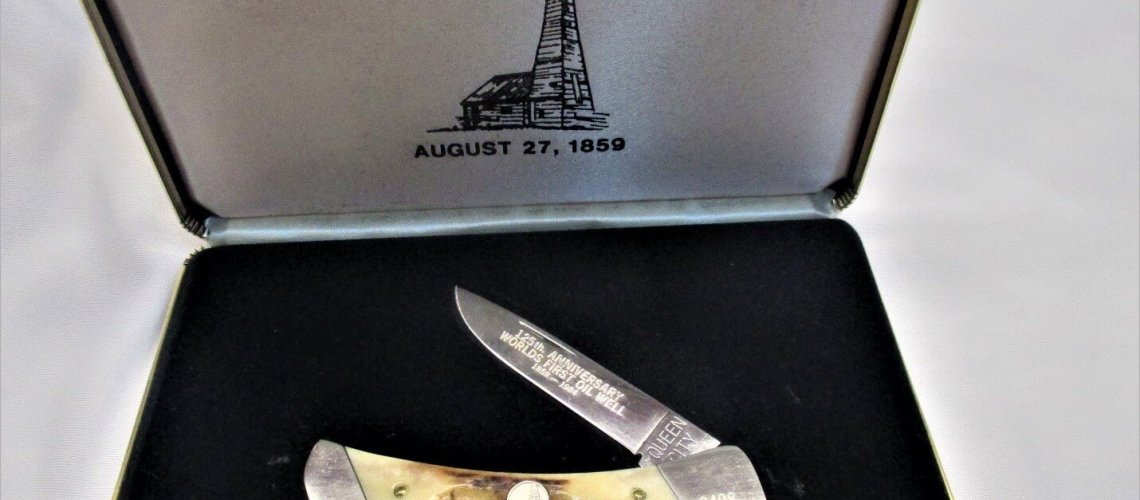
Dan Lago, Fred and Linda Fisher, November 24, 2023
Introduction.
I have always preferred lockback knives, probably because as a young, self-taught pocketknife user I cut myself on folding blades way too many times. When I started earning enough to buy more knives in the late 1960s- early 1970s, I bought many lockback knives. When I started to focus on Queen Cutlery, I liked their midsize knives, and they often were not expensive at the time ($15-25), good stainless steel, great pocket-size user knives; Every day carry (EDC) to the max.
These knives are all very similar in the construction, just over 4” in closed length, a 3 1/8” drop point stainless steel blade, a slightly curved handle, with an internal butt plate to strengthen the cap end. Knives differ in the way the cap end is finished, either in barehead showing (usually) two pins, or an exterior angled cap end bolster with pins ground smooth. Some knives show a more continuous curve from the handle all the way to the tip of the blade. Many of the Rawhides and the stag knives use less of an angle cut on the blade and lock, producing a straighter position for the blade.
Their popularity waned as the reintroduced Schatt & Morgan Keystone knives and collecting more traditional patterns took off for Queen, but through the ‘80s and ‘90s they sold well (the Rawhide #4225 had a full 20 years in the catalog). As you will see the knives shown in this article provide a nice demonstration of Queen’s practice of making a variety of knives to use up all parts in inventory to hustle another knife out for sale, from very humble working knives to very polished, beautiful knives in this pattern.
We summarize 19 different versions, mostly from my personal collection, but there are probably a number hidden in others’ collections or forgotten in various drawers. We go through them in roughly chronological order.
Review of Midsize lockback knives.
The first knife shown in Figure 1, seems to be an “Old Hickory” lockback, using the barehead handle with the name burned in, but with a clear tang stamp “Queen 1976,” blade. The knife was probably made under contract from Ontario Knife Company (OKC) during the early years of both companies being owned by Servotronics. It is now generally agreed that as sister companies, Queen made many of the folding knives for OKC (“Tree Farmer”, All about pocketknives.com, 5/22/2019). Fred Sampson, Queen’s Master Cutler at that time recalls, “Oh yes, we made the Old Hickories for Ontario.” Some of them had Delrin handles. I do not think we made many with Queen blades – theirs had the Andrew Jackson etch, which we used most of the time.” (Fred Sampson, Personal communication, 2023).
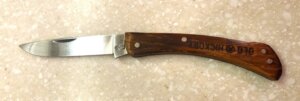
Figure 1. The first Queen-labeled midsize lockback, (dated with 1976 tang stamp), which shows an obvious design influence from Ontario Knife Company – (see Figure 2.) Somebody at Queen probably said at the end of a run, “Get one of those Queen 76 blades, put it on the leftover OKC handle, and send it out the door.” (Never cataloged.)
There is no documentation that we know of for the design of Queen’s midsize lockback, but it does seem that the Old Hickory collaboration with OKC might have played a significant role. There are no records or recollection of who designed the Rawhide Series of knives that we have found. So, the knife in Figure 1, might have used a blade in inventory to use up parts once the OKC contract was in process. But, some collaboration between these two companies might have been helpful in launching 20 years of middle sized lockbacks for Queen. “Monkey See. Monkey Do” was very common in American cutlery.
Figure 2, shows a completed Old Hickory knife with an OK tang stamp and the usually seen etch referring to President Andrew Jackson, the 7th President of the United States, from 1828 – 1837. It also seems that these handles were clearly made from Oak and not Hickory (nor Delrin).
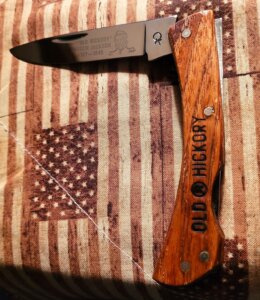
Figure 2. A complete “Old Hickory” midsize lockback showing etch and tang stamp, but with the same handle used for the knife in Figure 1. (Thanks to Paul Glassbrenner for this Internet photo and the link to “Treefarmer” 2019, post about these knives.)

Figure 3. The Gamekeeper Series included the #365 “Outdoorsman Micarta Lockback” knife, offered between 1978 and 1981 – at the very end of the Gamekeeper Series, but just before the introduction of the Rawhide lockback knife. The knife above is dated 1978 and is among the very first series of pocket knives Queen made with black Micarta handles, which might explain the barehead construction as a trial run with the very durable handle material.
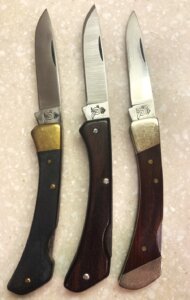
Figure 4. Three very early ‘80s versions of the #4225 (based on the tang stamp). The left knife was made with a brass bolster and pins with a stained black wood (does not seem to be “stabilized”) as Hawk or Rawhide series knives were. It and the middle knife up were also made with wooden barehead handles and only a single pin, (though the middle knife uses steel pins). The right knife in Figure 4, shows bolsters at both ends and does use two pins at the cap end. The blade is noticeably shorter and has been heavily sharpened and reprofiled. This knife and the left knife were built with a long curved topline from the cap end to the knife tip.
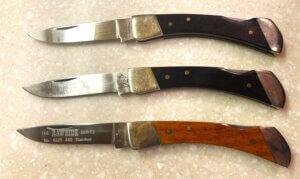
Figure 5. Rawhide and Hawks Series in the #4225 pattern. The bottom knife is an early Rawhide, first offered in 1980. You can see how straight the topline of the knife is compared to those in Figure 4. Though handle materials in Rawhide Series varied from darker wood and oak over the years, this knife was available for 20 years and was the first to use stabilized, plastic impregnated wood “Staminawood.” It is the most often seen midsize Queen lockback knife. Though “Qsteel” was very close to 440 stainless steel, the Rawhide knives were the first Queen product to highlight the popularity of 440 steel on their blade etches.
The middle knife in Figure 5, is a Hawk Series “Duck Hawk,” (same frame as the Rawhide, but labeled as model #1210) in black stamina wood. This knife was available for eight years, beginning in 1982, though was not cataloged from 1984-1988, the years when Queen suffered through a terrible downturn. The “Duck Hawk” was the popular name for the Peregrine Falcon. The top knife in Figure 5, shows a shorter blade and more “curved topline”. Although the photo does not show it well, it is not as well finished that the Duck Hawk below it -perhaps sold as a second with no etch. The handle is more “rounded” and may have been finished by the original owner compared to the sharper edges of the two catalog knives. Similarly, the blade may also show reprofiling by an owner. Many of these midsize lockbacks were Every day carry (EDC) knives.
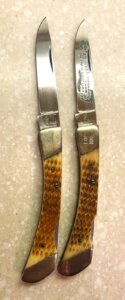
Figure 6. Bone limited edition versions of #4225 knives in “honeycomb” bone. Though never cataloged, bone versions of the midsize lockback were available for Special Factory Orders (SFO). This pair were made in 1983, with the right knife being bought by the TarHeels Cutlery Club for Youths in an edition of 100 serialized knives (a pretty nice gift for a young collector!). The left knife, exact in every way, is an “overrun” with no blade etch, made in the same edition, and sold to consumers. We have no idea how many of these SFO knives with special handles or etches were made and they may be the rarest of these Queen midsize lockbacks.
However, in my opinion, the best of Queen’s midsize lockbacks all came in 1983-84 in a series of stag versions with top quality stag and strong blade etches.
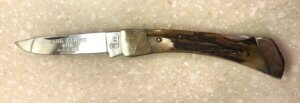
Figure 7. “Genuine Stag” Series Lockblade, (model #6115). The first lockback knife Queen made in stag and with deep blade etch characteristic of this series. This knife was only offered for one year, 1983 and is not easy to find.
The knives in this series were built off skill earned in producing a large edition of knives for the National Knife Collectors Association. The-National-Knife-Collectors-Association-bullhead-1981-2-19-2021.pdf (secureserver.net). Robert “Bob” Siple arranged that critical contract as he understood Stag handles were being scooped up by knife collectors. His insights and the commercial success of that venture led directly to the “genuine stag” Series through the early 1980s. Queen definitely saw the potential of this high-end collector knife and produced the following three versions, (Figures 8, 9, and 10) just before hard times hit the company in the middle ‘80s.
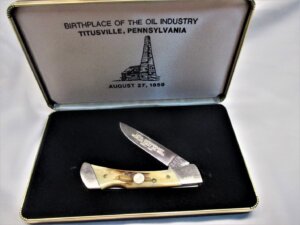
Figure 8. The 1984 Drake Well Commemorative Midsize lockback. The knife had a gold etch and for the first time used the early Queen City block lettering tang stamp on a modern knife. It also used a special shield showing the original Drake Well and was produced in a large edition of 1,500 knives. This knife was characterized by a rounder, smoother feeling than the pragmatic Rawhides it was based on. It just feels great in the hand.
Unlike the earlier Genuine stag #6115, this knife has stag handles that fit much better, not “bulbous” or pudgy; the extra care was taken to thin the stag on the inside of the covers so they fit smoothly. This despite the relatively large number of knives in this version (1,500). The black clamshell case and enclosed paperwork is relatively often found in good shape; This was a purely a collector knife and is still appreciated as such. It is strongly linked to Titusville’s history and production of numerous Drake Well commemoratives.
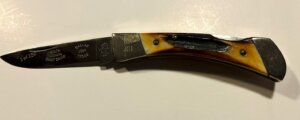
Figure 9. An example of the #6115 Genuine Stag knife produced as an incentive at the 1984 Shot Show. The blade has a colorful deep etch and announced only 150 are to be available. The knife is serialized and is hard to find, but the condition is usually good, because of the handle and etch. Some have argued that this knife was not packaged for display, but it is still sought because it was part of the first big plunge Queen made in producing stag handled knives and because of its limited-edition size. This particular knife shows a darker “torched” look to the Sambar stag compared tot eh knife in Figure 10. (Fred and Linda Fisher photo.)
It is also one of the last great collector knives Queen produced (under its own name) in the 1980s as a very serious economic collapse nearly killed the company. We cover that history in an article on our history of Queen Collector knives: Queen Cutlery Collector Knives, 1980s -1984. – Queen Cutlery Guide .
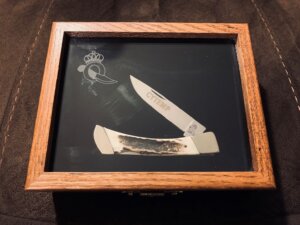
Figure 10. A Cytemp knife in Oak display box. The third limited edition midsize lockback knife in torched Inda stag, was distributed only to senior staff when the Cyclops Steel company in Titusville changed its name to Cytemp in 1984. They were said to have a very special quality of stag covers and to represent the best and most limited of the stag lockbacks produced by Queen in the 1980s. The etch boldly proclaims the company’s new name. The exact number produced is not known, but is reported to be less than 100 – 150 in the edition. The small oak box was the first time a Queen knife was presented in a wood display case and they were used in subsequent issues up till the company closed. (Internet photo).
Having all four of these stag knives built in the early 1980s would be a very difficult goal for any Queen collector! They are the peak of the midsize lockback knives Queen produced.
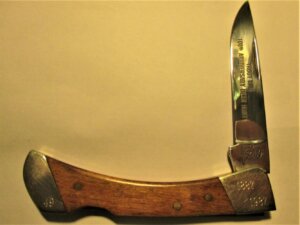
Figure 11. A commemorative knife for the Trout Run 100th Annual Deer Hunt. There might be other uses of the #4225 lockback as a “collector” knife, but I do like this one showing a rural Pennsylvania planning committee thinking like its membership in picking a very practical and cost-effective knife, by adding a deep etch on blade and bolsters with serial numbers. Living close to Trout Run Pennsylvania I was pleased to get this rare knife in my collection. We would love to know if any other groups used these knives for their celebrations.

Figure 12. Second version of the “outdoorsman” Knife in 1991, with a new model number (#1500) and grooved matte Delrin handle. This knife shows a tang stamp of 1991. The handle on this knife is quite thin and seems to have been built for a person with small hands or in a very modern style. This knife was also made only for a short time and is not seen very often.
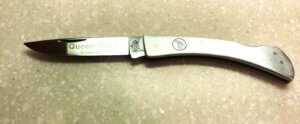
Figure 13. The aluminum handled version (Model #6125), built on the same pattern as the #4225 midsize lockback. This knife was made only during 1994-1995, is not often seen and is often found in relatively poor condition. In my opinion, like most unfinished aluminum handles, they tend to oxidize in the pocket over time and are sometimes dirty your hand. They are not my favorite of this pattern. Again, like the other early 199os knife (see figure 12) it is also quite thing and with fairly sharp edges on the handle – not really meant for heavy use.
The Tarheels Cutlery Club (see Figure 5) also commissioned an aluminum model of this knife for their youth knife in a subsequent year, with a similarly green deep etch – a rarely seen knife.
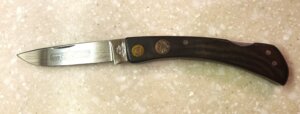
Figure 14. A 2014, #1500 midsize lockback in Olive Drab linen micarta. This knife has a “fisheye” pin for the blade, an inscribed Queen shield, and is bareheaded. The micarta handles are very substantial, wider and rounded a bit, and with D2 steel, this is easily the most functional and sturdy version of this pattern, by the Daniels Family Cutlery. You can see that the drop point blade shows a similar curve to some of the early knives in this pattern. In my opinion this places a little more emphasis on the curve of the blade and a bit less on the lower straight section of the blade, making it a bit handier for butchering.
This particular knife has fairly dark covers and some show almost as brown, while some are a much lighter olive drab color. This knife was offered for only one year and again, is not often seen and often shows harder use than purely collector knives.
The Olive drab Micarta knife was the last of this pattern. The Daniels Family Cutlery shifted its attention to the larger Mountain man lockblade, the John Henry and Mountain Man Express knives, and the “Woodsman” lockblade. The latter is almost the same size as the #4225 and built like a smaller version of the popular Mountain man. They are all seen as more desirable by modern collectors. Some of us still like the early ones. So, while the 1980s style lockback knives by Queen can be viewed as dated, they show a variety of finishes, were extremely functional for users, and helped the company weather the financial storm of the middle 1980s.
This is a first edition and we would appreciate photos of knives in your collection that we can add to this summary. Or any other comments or suggestions you have. We also thank those who have posted copies of their knives on public Internet sites for viewing. Thank you.
References.
Gamekeeper-10-2019.pdf (queencutleryguide.com) for model 365, “outdoorsman micarta lockback”
Olive-Drab-Green-Linen-Micarta-10-2019.pdf (queencutleryguide.com)
Hawk-Series-10-2019.pdf (queencutleryguide.com)
Aluminum-10-2019.pdf (queencutleryguide.com)
Fisher, Fred & Dan Lago (2019) Hawk-Rawhide-lockbacks-review-8-2019.pdf (queencutleryguide.com)
Lago, Dan (2020)The-National-Knife-Collectors-Association-bullhead-1981-2-19-2021.pdf (secureserver.net).
Sampson, Fred R. (2023) Personal Communication.
Tree Farmer,(2019) Old Hickory/Queen. All about pocketknives.com, 5/22/2019).

